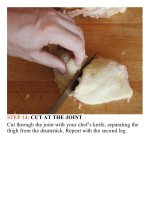The food lab better home cooking through science ( PDFDrive ) 774
Bạn đang xem bản rút gọn của tài liệu. Xem và tải ngay bản đầy đủ của tài liệu tại đây (176.63 KB, 2 trang )
that wonderfully complicated process by which amino
acids and reducing sugars recombine to form enticing
roasty aromas—really begins to take off. At this range,
meatwillquicklybrownandcrisp.
Ah—a dilemma revealed itself: In order to maximize
browning,Ihadtocookthemeatinasufficientlyhotoven
—Itried400°F.Butthesametime,Ididn’twanttheinterior
toreachabove125°F.Sinceabigbeefroastcooksfromthe
outsidein,bythetimethecenterhadreached125°F(thatis,
120°F in the oven, followed by a 5-degree rise in
temperature after resting), there was a perfectly browned
exterior,buttheoutermostlayershadrisenclosertoaround
165°Fto180°F,renderingthemovercooked,gray,anddry,
theirjuiceshavingbeensqueezedout.
Iwasleftwithsomethingthatlookedlikethis:
Iknow,Iknow—notpretty.
Score:
•CommandmentI:PerfectCrust?Check.
•CommandmentII:NoGrayZone?Negative.
•CommandmentIII:Full-onJuiciness?Negative.
OK, so what if I went to the opposite extreme, cooking
the roast at a much lower temperature? I cooked another
roastina200°Fovenuntilthecenterreached125°F.Well,
justaswithboiledeggs,thetemperatureatwhichyoucook
is directly related to the difference in temperatures between
thecenterandtheoutsidelayers.Inotherwords,bycooking
it at a lower temperature, you minimize the proportion of
beefthatgoesabovetheidealfinaltemperature.Iwasable
to eliminate the gray band of overcooked meat almost
completely.Ofcourse,anybrowningwasalsorightoutthe
window,leavingmewitharoastwithpale,anemicexterior.
Again,notpretty.









